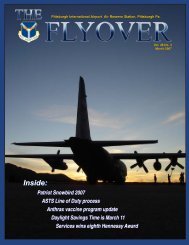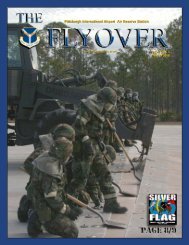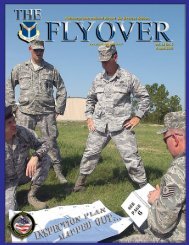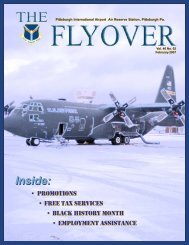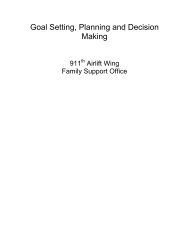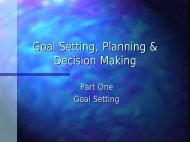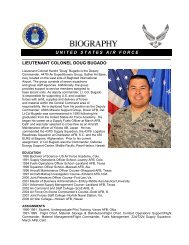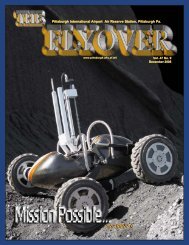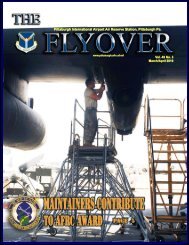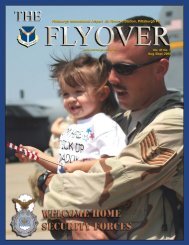Inside: - Pittsburgh IAP Air Reserve Station - Air Force Link
Inside: - Pittsburgh IAP Air Reserve Station - Air Force Link
Inside: - Pittsburgh IAP Air Reserve Station - Air Force Link
You also want an ePaper? Increase the reach of your titles
YUMPU automatically turns print PDFs into web optimized ePapers that Google loves.
The Flyover<br />
News<br />
September 2007<br />
American women traveled a long,<br />
arduous path to the ballot box<br />
Capt. Marlo Foster<br />
911 AES<br />
With the candidates scurrying to<br />
grab votes for the upcoming<br />
presidential election, it is hard to<br />
think that there was a time when<br />
everyone could not vote. Women<br />
in particular, once, were the least<br />
thought of to have a voice in our<br />
political leadership.<br />
The push for women to vote<br />
began in the mid 1800’s, when the<br />
“Woman suffrage movement”<br />
was born. During this time many<br />
women began speaking out on<br />
issues such as antislavery and<br />
social, legal, financial and<br />
educational reform. A few<br />
Americans who were a part of this<br />
movement were Susan B.<br />
Anthony and Elizabeth Stanton. In<br />
later efforts as the movement<br />
grew, Sojourner Truth would also<br />
be among these women’s rights<br />
activists.<br />
In 1869, two woman suffrage<br />
organizations were initiated that<br />
had two different views on the<br />
ratification of the fifteenth<br />
amendment. The first was The<br />
National Woman Suffrage<br />
Association (NWSA), which was<br />
headed by Susan B. Anthony and<br />
Elizabeth Cady Stanton. They<br />
opposed the fifteenth amendment<br />
but supported the sixteenth<br />
amendment which would franchise<br />
women. The second, The American<br />
Woman Suffrage Association<br />
(AWSA), led by Lucy Stone,<br />
supported the fifteenth amendment<br />
and also worked for woman<br />
suffrage.<br />
The AWSA spoke in various<br />
states all across the nation and<br />
established local and state suffrage<br />
organizations. They also handed out<br />
literature and utilized the<br />
newspapers to promote state<br />
suffrage changes, such as bills<br />
giving women the right to vote on<br />
school or municipal issue and also<br />
in presidential elections.<br />
The NWSA’s belief was that as<br />
citizens, they could not be deprived<br />
of their rights as protected by the<br />
Constitution. Susan B. Anthony tried<br />
to vote in 1872. Her intention was<br />
to be arrested and to take her beliefs<br />
to the courts. She was indeed<br />
arrested and charged with<br />
knowingly, wrongfully and<br />
unlawfully voting for a<br />
representative to the Congress of<br />
9<br />
the United States. She was found<br />
guilty and ordered to pay a fine that<br />
she decided she would not pay.<br />
Another suffrage movement, the<br />
Woman’s Christian Temperance<br />
Union (WCTU) began in 1880. The<br />
WCTU saw the woman’s suffrage<br />
as a catalyst to the protection of<br />
home, women and children. In<br />
1890 the NWSA and the AWSA<br />
merged to form the National<br />
American Woman Suffrage<br />
Association (NAWSA). Elizabeth<br />
Cady Stanton served as president<br />
and Susan B. Anthony was vice<br />
president. This association<br />
decided that they needed to win<br />
the support of each state in order<br />
to make congress approve a<br />
federal amendment. Although the<br />
NAWSA tried to exclude African<br />
American women, a growing<br />
number of African-American<br />
women actively supported woman<br />
suffrage. As Adella Hunt stated;<br />
“If white women needed the vote<br />
to protect their rights, then black<br />
women-victims of racism needed<br />
the ballot even more.”<br />
Many women fought tirelessly<br />
and succeeded in the women’s<br />
right to have a say in our country’s<br />
future. The suffrage movement<br />
persisted, and in 1919 Woodrow<br />
Wilson finally led congress to<br />
approve the nineteenth amendment<br />
and submit it to the states. On August<br />
26, 1920 the nineteenth amendment<br />
was added to the United States<br />
Constitution.<br />
Who was the first woman to<br />
vote Women in New Jersey had<br />
the right to vote from 1776-1807<br />
and no records were kept as to the<br />
time of each vote, therefore the first<br />
woman to vote is unknown.



